Hamlet by William Shakespeare is one of the most celebrated works of English literature that deeply investigates themes of betrayal, revenge, madness, and morality. If you need some help understanding the play’s entangled plot, read our Hamlet summary. On this page, we will present a brief summary of the play, scene-by-scene descriptions, a comprehensive Hamlet overview, and an analysis to assist readers in grasping the play’s depth.
Whether you need a Hamlet summary essay, a full synopsis, or a downloadable PDF file for reference, this guide covers all bases. From the ghost’s revelation to Hamlet’s tragic end, you’ll gain insights into every pivotal moment of the play. Let’s dive into the plot and explore detailed scene summaries!
📝 Hamlet: Synopsis
Hamlet, Prince of Denmark, studies in Germany. Suddenly, his father dies. As Hamlet comes home to his dad’s funeral, he discovers that his mother marries his uncle Claudius, who now takes the throne. Frustrated about his mother’s betrayal and uncle’s new status, Hamlet gets lost in his thoughts.
The tension becomes even stronger when Prince sees the Ghost of his father. The spirit claims that Claudius is the murderer and commands Hamlet to revenge. Prince is confused. His inner hesitation leads to impulsive actions that result in tragic consequences.
If this Hamlet overview too short for you, proceed to the plot summary below.
🗃️ Hamlet: Short Summary
Act 1: Scene 1
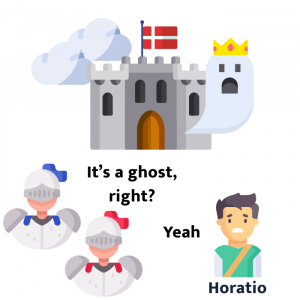
The action opens at Elsinore Castle in Denmark during the night. The guards notice the Ghost of the recently dead King. Being unsure of what they have witnessed, they bring Horatio, a learned scholar and friend of Prince. Horatio admits the presence of the Ghost and decides to share this mystery with Hamlet.
Act 1: Scene 2
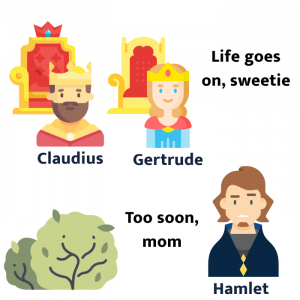
Upon receiving news about his father’s death, the Prince of Denmark immediately returns from his university in Wittenberg, Germany, to attend the funeral. Then, Hamlet’s plot includes an unexpected twist. Hamlet’s mother, Gertrude, marries Hamlet’s uncle, Claudius. Prince is disgusted by her decision to fall for another man right after her husband’s demise. What is more, Claudius becomes the new King of Denmark, which makes Hamlet even more frustrated.
Act 1: Scene 3
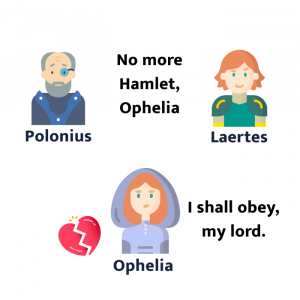
Meanwhile, the King’s advisor, Polonius, prepares his son, Laertes, for school in Paris. His sister, Ophelia, comes to say goodbye to him. Polonius and Laertes suspect that she has romantic feelings towards Hamlet. They warn her to stay away from Prince. She promises to her father and brother not to interact with Hamlet.
Act 1: Scene 4

The night comes, and the Ghost of the dead King appears in front of Hamlet, Horatio, and Marcellus. Everyone is shocked, yet Prince decides to follow the spirit, who seems to seek his company. His friends disagree, and that’s when Marcellus says, “Something is rotten in the state of Denmark.”
Act 1: Scene 5

And so, Hamlet follows the Ghost. The spirit claims that Claudius is his murderer as he poisoned him to take the throne. He orders Hamlet to avenge him, and Prince quickly promises to do so. Later, he informs Horatio and Marcellus about his intentions. Also, he warns them that he is going to pretend mad until he gets revenge.
Act 2: Scene 1
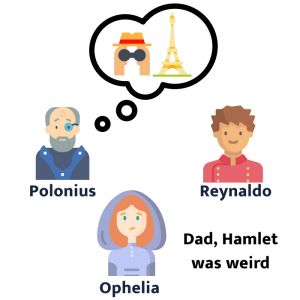
Hamlet starts developing his plan of revenge. To confuse everyone around, he starts acting in a very erratic and alarming way. Polonius is confident that Hamlet is mad because Ophelia rejected him according to her father’s wish. He instructs his servant, Reynaldo, to spy on Laertes in Paris when Ophelia comes and describes her latest encounter with Prince.
Act 2: Scene 2

Gertrude is concerned about her son’s mental state. She asks Hamlet’s school friends Rosencrantz and Guildenstern to discover the cause of his strange behavior. Besides, Claudius is also worried, especially after Polonius’s suspicions. The advisor plots the plan to spy upon Hamlet. Yet, Prince sees through all his spies and mocks them.
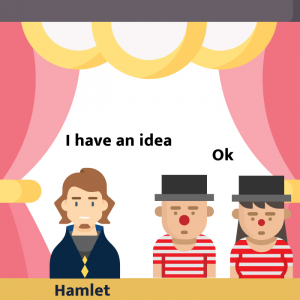
Hamlet also develops his plan. A troop arrives at the castle to show a performance. Hamlet asks the actors to change their play, The Murder of Gonzago, a bit and add a scene that would depict his father’s death. Hamlet believes that Claudius’s reaction will reveal his guilt.
Act 3: Scene 1
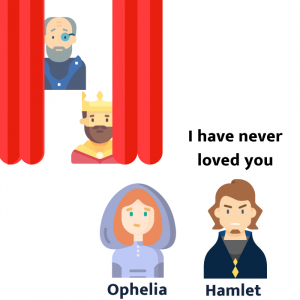
Polonius and Claudius engage Ophelia in their evil plan. They ask the lady to meet Hamlet to return his presents and talk. During their meeting, Hamlet acts inadequately. He accuses innocent Ophelia of being two-faced and claims that he had never loved her. The lady is confused and frustrated, while Claudius and Polonius are overwhelmed.
Now, the King is uncertain of the real cause of Hamlet’s madness. Claudius becomes paranoid as he thinks that Prince knows the actual circumstances of his father’s death. He decides to send Hamlet to England. However, Polonius offers the King to make Prince reveal his inner thoughts to Gertrude, with the advisor eavesdropping. Claudius agrees.
Act 3: Scene 2

The troop performs the play, The Murder of Gonzago, which Hamlet directed. He asks Horatio to watch the King’s and Queen’s reactions to the story. He wants to guilt his mother and show his uncle’s true colors. Claudius’s response to the scene when the King is poisoned was suspicious, as noted by Horatio. It makes Hamlet sure Claudius is the real murderer.
Act 3: Scene 3

Now Claudius knows that Hamlet learned his secret. Unsure what to do, he asks Rosencrantz and Guildenstern to go to England with Prince. Then, he tries to pray, though he’s uncertain how. Meanwhile, Hamlet wants revenge on his uncle as soon as possible yet sees Claudius praying and hesitates. The man might go to heaven if he is killed right after the prayer. So, Prince decides to wait.
Act 3: Scene 4
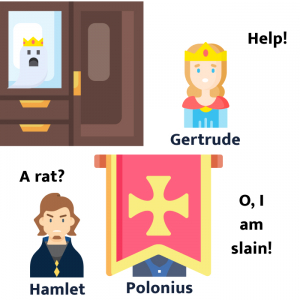
The next episode of Hamlet’s plot summary takes place in Gertrude’s bedroom. The mother and the son have an intense conversation while Polonius is spying upon them behind the tapestry. Hamlet hears a noise. Enlarged, he stabs the tapestry and, consequently kills Polonius.
Gertrude is in shock, yet Hamlet doesn’t understand what happened. He sees the Ghost, who reminds him about the revenge. So, Hamlet begs his mother to stop sinning, promises that he’s sane, and leaves with the corpse.
Act 4: Scene 1
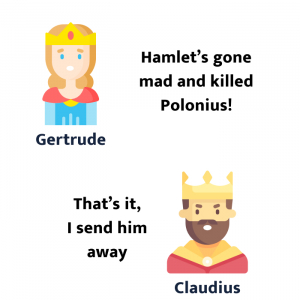
Claudius learns about Polonius’s demise from Gertrude. Afraid of Hamlet’s enlarged behavior, Claudius fears for his own life. He arranges everything to send Hamlet to England. Meanwhile, Gertrude acts as if her son has gone mad, according to his plan (or her understanding of the situation).
Act 4: Scene 2
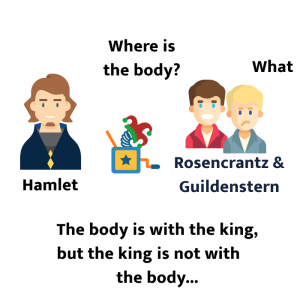
According to Claudius’ order, Rosencrantz and Guildenstern ask Hamlet to give them Polonius’s body. Prince mocks them some more, yet his childhood friends don’t understand his riddles and jokes. After the punchline where Hamlet mocks the King, he runs off.
Act 4: Scene 3
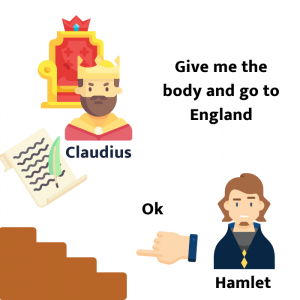
Now Claudius questions Hamlet regarding the corpse, and Prince jokes again and again. Finally, he reveals the body’s location while Claudius sends him to England with Rosencrantz and Guildenstern. Left alone, the King writes a secret letter where orders to kill Hamlet as soon as he arrives.
Act 4: Scene 4
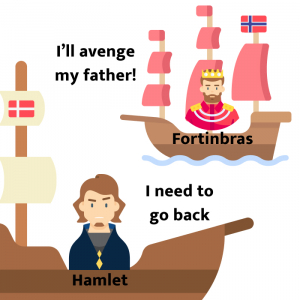
On his way to England, Hamlet sees Fortinbras, nephew of the King of Norway. He leads his fleet to Poland (it should’ve been Denmark, but his uncle forbade this attack), trying to honor his father. It reminds Hamlet of his promise to the Ghost and gives him the confidence to go back to avenge his father.
Act 4: Scene 5
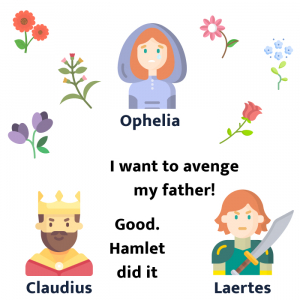
Meanwhile, Ophelia finds out that her father, Polonius is dead. Being desperate about her loss, she goes mad and starts handing out symbolic flowers to everyone. Besides, Laertes returns, and Claudius explains the situation to him. Now, Laertes wants to avenge his father.
Act 4: Scene 6

Horatio receives the letter from Hamlet where he states that he was taken as a prisoner by some pirates. In other words, he is on his way to Denmark. Horatio sends the letter to the King and Queen and rushes to see Hamlet.
Act 4: Scene 7
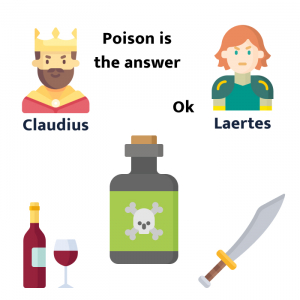
Upon receiving the letter, Claudius and Laertes plot how to kill Hamlet to get rid of all the problems he causes. The King comes up with the idea: he will arrange the duel between the young men. Laertes will sharpen and secretly poison his sword, so even the tiniest nick would kill Hamlet immediately. Moreover, they will poison a glass of wine and offer it to Prince if Laertes fails to wound him.
Suddenly, Gertrude arrives with bad news: Ophelia committed suicide, having drowned in a brook.
Act 5: Scene 1

Hamlet visits the graveyard, accompanied by Horatio. Prince notices Yorick’s skull and ponders upon a matter of life and death. That’s when Ophelia’s funeral starts, and Hamlet learns about her death. Laertes jumps into her grave, declaring his love, and Prince reveals himself right after. The men argue, with Laertes blaming Hamlet for the deaths of his close relatives. Prince challenges him for a duel, and so it will be.
Act 5: Scene 2
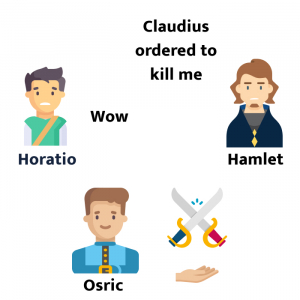
Hamlet explains to Horatio why he came back. In short, he saw Claudius’ letter and forged it. Now it states that Rosencrantz and Guildenstern should be murdered instead of him. So, they die in England in the meantime. The whole situation makes Hamlet confident in his decision to kill Claudius.
Meanwhile, Osric, a courtier, comes to discuss the details of the upcoming duel. Hamlet mocks him, but they agree on the terms.
How does Hamlet end?

The duel between Hamlet and Laertes starts. Gertrude accidentally (or not?) takes a sip of the poisoned wine that Claudius prepared for Prince. At that moment, Laertes wounds Hamlet. They grapple, and, as a result, Hamlet stabs Laertes with his own sword. Gertrude dies due to the poisoned wine. Laertes reveals to Hamlet Claudius’s evil plan. Furious, Hamlet stabs his uncle with the poisoned blade, killing him. Laertes asks for forgiveness and also dies.
Seeing that Hamlet is dying, Horatio wants to drink the poisoned wine. Yet, Prince asks him to stay alive for him and tell his story. In the last seconds of his life, he declares Fortinbras (who has just arrived from Poland) the next ruler of Denmark. Then, Hamlet dies.
🔖 Hamlet: Analysis
Written more than four centuries ago, Hamlet remains one of the most widely-known William Shakespeare’s works. Partially, such popularity is due to its intriguing plot. Yet, most importantly, the author explores layered topics and themes by creating an unconventional hero.
Hamlet’s plot structure is quite simple. There are five acts, each of which has several scenes. Such an organization helps the readers follow the flow of events in the play and catch every detail.
Hamlet includes all five elements of the basic plot structure:
- Exposition: King Hamlet is dead, Hamlet arrives, the Ghost appears and calls revenge.
- Rising action: Hamlet’s inner dilemma whether to revenge Claudius or not.
- Climax: Hamlet makes sure that Claudius is guilty and accidentally kills Polonius.
- Falling action: Claudius and Laertes plots a plan of how to get rid of Hamlet.
- Resolution: the bloody death of all the central characters.
In the play, William Shakspeare makes a vivid confrontation between Hamlet and Claudius. Prince is introduced to the readers as the man of doubts. He is indecisive, incapable of making serious decisions, and lost in his thoughts. Claudius, in contrast, is a man of action. The King has a clear vision of his actions and is completely capable of controlling his emotions. The more Claudius knows, the easier for him to make a decision and steer his knowledge in the right course. However, the more Prince knows, the more lost in his thoughts and confused he becomes.
Throughout the story, the readers notice more and more evidence that supports Hamlet’s indecisiveness. One of the examples is his famous soliloquy, “To be or not to be.” Prince is not sure whether he is ready to die or continue living. He admits that death is inescapable, just like life. Hamlet hopes that passing will end all his sufferings but fears what comes after it. The dilemma in Hamlet’s head leads him to a harrowing conclusion: he regrets that he even was born. He realizes that people are unaware of what death foreshadows. Hamlet’s inner suffering progresses. As a result, he becomes impulsive and commits reckless actions.
Another significant conflict in Hamlet is gender roles in society. Ophelia and Gertrude are two central women in the play. But do they have any power? They are presented as two pawns in the hands of men, who use women for their benefit. Firstly, Claudius marries Gertrude to take the throne. Then, Polonius and Claudius plan an “occasional” meeting of Hamlet and Ophelia to spy upon Prince. After that, they use Gertrude to make Hamlet reveal the truth about his mental state and problems. Although both Ophelia and Gertrude are concerned about Prince, they should carry out the orders of men without expressing their feelings towards him.
We hope that Hamlet’s summary and analysis prepared by our team helped you to understand the play on a deeper level. Don’t forget to share this webpage with your peers. And check the links below for further investigation of Hamlet.
